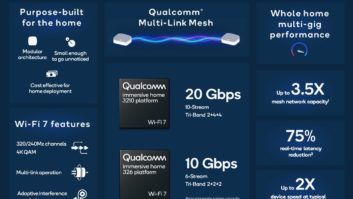MoCA recently concluded field tests that compared three different Wi-Fi mesh-based products in a home networking environment, versus a Wi-Fi network that used MoCA as the backhaul. The results showed a dramatic improvement in Wi-Fi performance when using MoCA 2.0 as the backhaul, compared to a Wi-Fi-based backhaul only.
Wi-Fi mesh has been getting a lot of attention lately as an alternative for whole-home coverage. The Alliance conducted these tests to determine if Wi-Fi mesh-based products could sustain performance throughout a typical U.S. home with multiple streams of traffic running concurrently.
All devices tested included 802.11ac fronthaul. Netgear’s Orbi, Plume, and Eero, which integrate 802.11ac backhaul, were compared to Actiontec Wi-Fi extenders that integrate MoCA 2.0 Bonded backhaul. All devices used are currently available via retail channels so as to test products that consumers can purchase today.
Per the graph below showing cumulative distribution results for TCP traffic type, MoCA 2.0 Bonded extenders delivered 800Mbps or better downlink Wi-Fi performance in all homes. Orbi was able to achieve 300Mbps or better in 50 percent of homes, though some homes were capable of only 170Mbps. Eero and Plume were unable to reach 200Mbps at all. See TCP Traffic (A).

TCP Traffic (A)
Uplink traffic with Wi-Fi was also significantly greater when using MoCA technology as the backbone compared to using Orbi, Eero, or Plume.
Testing of UDP traffic showed similar improvements in performance when using MoCA technology as the wired backbone. See UDP Traffic (B).
“Whole-home coverage and sustained performance in the home go hand in hand, but can be difficult to achieve without a wired backhaul. The beauty in this is, MoCA leverages the already existing coax as its backhaul,” said Charles Cerino, MoCA president. “These tests demonstrate that while Wi-Fi mesh may offer some improvement in whole home coverage, it is not consistent and a wire is still critical for the highest performance and lowest latency in every room.”
Dekra (formerly AT4Wireless) performed the tests and recorded the results from 11 homes around the country including Georgia, New Jersey, Virginia, Pennsylvania, Colorado, and California.

UDP Traffic (B)
Nine Wi-Fi clients were deployed throughout each test house. Client location remained the same for all five system tests. For each system, Dekra turned off all clients, set up and enabled new APs, and then turned on all clients. Clients were not manually connected to a particular AP.
Traffic types were TCP and UDP, downlink and uplink. Traffic was sent to all clients individually in 60-second intervals in one test. In another test, traffic was sent to all nine endpoints simultaneously—most closely representing real world usage.







